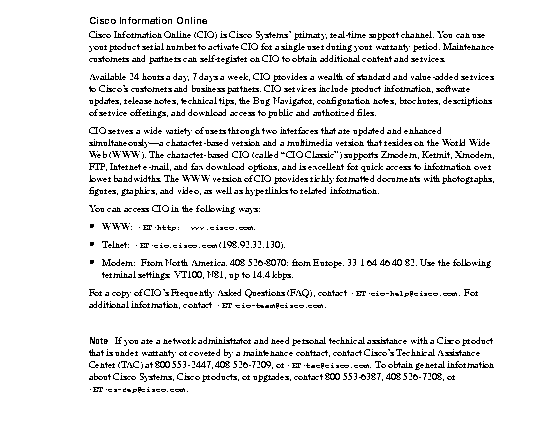Supplement to DOC-CDDI/FDDIUG (Document Number 78-1267-01)
Supplement to DOC-EISAHPUM1 (Document Number 78-1276-01)
Supplement to DOC-WGEISASGIUG1 (Document Number 78-1400-01)
Supplement to DOC-SBUSUG1 (Document Number 78-1277-01)
For all WS-C300T series Turbo SBus Adapter part numbers
For all WS-C320T series Turbo EISA Adapter part numbers
This release note describes the features, modifications, and resolved issues of Adapter Flash Code Version 4.4, which is used with all CDDI/FDDI EISA PC, EISA HP, EISA SGI, and SBus Turbo adapters. Refer to the following documents for detailed information about these products:
- Workgroup CDDI/FDDI EISA PC Adapter User Guide
- Workgroup CDDI/FDDI EISA HP Adapter User Guide
- Workgroup CDDI/FDDI EISA SGI Adapter User Guide
- Workgroup CDDI/FDDI SBus Adapter User Guide
For detailed explanations of product features and functions, see the chapter "Product Overview" in the documents listed above. For Flash code update instructions, see the chapter "Using the Download Utilities" in the documents listed above.
The CDDI/FDDI EISA PC, EISA HP, EISA SGI, and SBus adapters connect workstations and servers to CDDI and FDDI networks. High-performance workgroup adapters connect workstations and servers to CDDI or FDDI networks.
This section of the release note describes the features and resolved issues incorporated between Version 4.4 and Version 4.2/4.3 of the Adapter Flash code.
The following feature has been added:
- This version of Adapter Flash code allows adapters to change their MAC address dynamically when instructed to by the host.
The following issues have been resolved:
- Version 4.2--The workstations beacon process has been changed when the timer valid transmission (TVX) timer expires to the following sequence:
- The station will transmit claim frames.
- If the station is unable to resolve the claim process, the station will then transmit regular beacon frames.
- If the station is unable to resolve the beacon process, the station will then transmit directed beacon frames.
Note This is the correct sequence of events as defined by the SMT standard.
- Version 4.2--To improve receiver performance, the receive threshold value in the MAC has been changed to 0xF (15) from 0x4 (4). This will allow the bus interface gate array (BIGA) to start the direct memory access (DMA) process on the received frame after receiving only 240 bytes.
- Version 4.2--The receiver hung error condition will now be sent to the host repeatedly.
- Version 4.3--External ring up and ring down are now reported properly.
This section of the release note describes the feature and resolved issues incorporated between Version 4.2 and Version 3.5 of the Adapter Flash code.
Note Adapter Flash Code Version 3.5 was the last version of Adapter software released for general availability to CIO and for installation on adapters in manufacturing.
The following feature has been added:
- This version of the Adapter Flash code makes the adapters fully compliant with Station Management (SMT) Revision 7.3.
The following issues have been resolved:
- Version 3.5--When you use fddistat (the FDDI status utility) with the SBus dual attachment station (DAS) adapter, an incorrect media type is no longer reported in the FDDI Adapter Statistics display.
- Version 3.5--Change default MAC Treq value from 15,000 to 165,000 microseconds.
This section of the release note describes the features and resolved issues incorporated between Version 3.6 and Version 3.5 of the Adapter Flash code.
Note Adapter Flash Code Version 3.6 was released for general availability to CIO only.
The following feature has been added:
This version of Flash code is compatible with either onboard or daughter card MLT-3/PMD adapter boards.
The following issues have been resolved:
- Version 3.5--When you use fddistat (the FDDI status utility) with the SBus dual attachment station (DAS) adapter, an incorrect media type is no longer reported in the FDDI Adapter Statistics display.
- Version 3.5--Change default MAC Treq value from 15,000 to 165,000 microseconds.
This section of the release note describes the resolved issue between Version 3.5 and Version 3.4 of the Adapter Flash code.
The following issue has been resolved:
- Version 3.4--When the memory registers were read to determine the status of the optical bypass switch, which is connected to the dual attachment station adapters, a false response would sometimes appear even though an optical bypass switch was connected. The software has been modified to always read true whether an optical bypass switch is connected or not.
This section of the release note describes the resolved issues between Version 3.4 and Version 3.3 of the Adapter Flash code.
The following issues have been resolved:
- Version 3.3--When you change the Media Access Control (MAC) mode from promiscuous to nonpromiscuous, the MAC no longer halts.
- Version 3.3--When you use fddistat (the FDDI status utility) with the SBus dual attachment station (DAS) adapter, an incorrect media type is no longer reported in the FDDI Adapter Statistics display.
- Version 3.3--Station Management only sends a status reporting frame (SRF) to the ring when there is a link error rate (LER) condition. Previously, when there was a LER condition, three things would happen: the link confidence test (LCT) was long, the port would reset, and an SRF would be sent to the ring.
- Version 3.3--When the network connection cable is unplugged and plugged in again, the MAC mode transitions no longer halt the transmitter.




